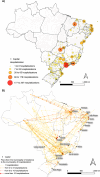Factors associated with hospitalizations due to severe malaria in the non-endemic Brazilian region: a case-control study in the extra-Amazon Region from 2011 to 2019
- PMID: 40652249
- PMCID: PMC12255989
- DOI: 10.1186/s12936-025-05357-y
Factors associated with hospitalizations due to severe malaria in the non-endemic Brazilian region: a case-control study in the extra-Amazon Region from 2011 to 2019
Abstract
Background: Malaria is infectious disease with low occurrence in Brazil extra-Amazon Region. Despite this, higher lethality is observed in this region compared to the country's endemic area. Therefore, this study aimed to analyse factors associated with malaria hospitalizations (severe malaria) in the extra-Amazon Region, in order to prevent deaths.
Methods: A case-control design was used, utilizing data from the Brazilian Notifiable Diseases Information System (Sinan) and hospitalization records from the Unified Health System (SIH/SUS) from 2011 to 2019. Cases comprised hospitalized malaria patients, while controls included reported malaria notifications without hospitalization. Probabilistic record linkage techniques were employed, and associations were analysed using multiple logistic regression with a 0.05 significance level.
Results: The main risk factors identified were: Black or mixed-race ethnicity (OR = 1.22; 95% CI 1.04-1.43), low education (elementary school OR = 2.21; 95% CI 1.78-2.75 or high school OR = 1.72; 95% CI 1.39-2.13), infection outside the extra-Amazon Region (Amazon Region OR = 1.50; 95% CI 1.15-1.96 or abroad OR = 1.72; 95% CI 1.28-2.32), high parasite count (501 to 10,000/mm3 OR = 1.51; 95% CI 1.27-1.80, 10,001 to 100,000/mm3 OR = 1.77; 95% CI 2.87-1.96 or higher than 100,000/mm3 OR = 3.15; 95% CI 2.20-4.50) and delayed treatment (after 3-7 days symptoms onset OR = 1.74; 95% CI 1.36-2.24 or 8 days or more OR = 2.08; 95% CI 1.62-2.66). Active case detection was a protective factor (OR = 0.65; 95% CI 0.54-0.78).
Conclusions: Delayed treatment remains a key factor in the occurrence of severe malaria, leading to high parasitaemia and revealing inequalities in access to healthcare based on socioeconomic differences. Travel to the Amazon Region or other countries also poses a challenge, requiring strengthened traveller health strategies and increased surveillance awareness to promptly suspect and identify cases.
Keywords: Epidemiological surveillance; Epidemiology; Extra-Amazon Region; Hospital admissions; Hospitalizations; Malaria; Severe malaria.
© 2025. The Author(s).
Conflict of interest statement
Declarations. Ethics approval and consent to participate: In compliance with the National Health Council Resolution No. 510 of April 7, 2016, the study was submitted to the Research Ethics Committee at the University of Brasília (CEP/UnB). Approval for data handling and linkage is documented in the committee’s re-port number 5.008.210. Measures were taken to mitigate the risk of exposing personal data, in accord-ance with the General Data Protection Law (LGPD)—Law No. 13.709 of August 14, 2018. Consent for publication: Patient consent was waived according to the Brazilian National Health Council resolution number 510/2016 which states that research using secondary data of National Databases do not require patient’s consent to be conducted. Competing interests: The authors declare no competing interests.
Figures


Similar articles
-
Mefloquine for preventing malaria during travel to endemic areas.Cochrane Database Syst Rev. 2017 Oct 30;10(10):CD006491. doi: 10.1002/14651858.CD006491.pub4. Cochrane Database Syst Rev. 2017. PMID: 29083100 Free PMC article.
-
Mosquito aquatic habitat modification and manipulation interventions to control malaria.Cochrane Database Syst Rev. 2022 Nov 11;11(11):CD008923. doi: 10.1002/14651858.CD008923.pub3. Cochrane Database Syst Rev. 2022. PMID: 36367444 Free PMC article.
-
Association between anthropometry-based nutritional status and malaria: a systematic review of observational studies.Malar J. 2015 Sep 17;14:346. doi: 10.1186/s12936-015-0870-5. Malar J. 2015. PMID: 26377094 Free PMC article.
-
Surveillance for Violent Deaths - National Violent Death Reporting System, 50 States, the District of Columbia, and Puerto Rico, 2022.MMWR Surveill Summ. 2025 Jun 12;74(5):1-42. doi: 10.15585/mmwr.ss7405a1. MMWR Surveill Summ. 2025. PMID: 40493548 Free PMC article.
-
Indoor residual spraying for preventing malaria in communities using insecticide-treated nets.Cochrane Database Syst Rev. 2022 Jan 17;1(1):CD012688. doi: 10.1002/14651858.CD012688.pub3. Cochrane Database Syst Rev. 2022. PMID: 35038163 Free PMC article.
References
-
- WHO. World malaria report 2024. Geneva: World Health Organization; 2024.
-
- Brazil. Malaria control programme-Tableau Public. https://public.tableau.com/app/profile/mal.ria.Brazil/viz/Dadosparacidad.... Accessed 12 Oct 2024.
MeSH terms
LinkOut - more resources
Full Text Sources
Medical

